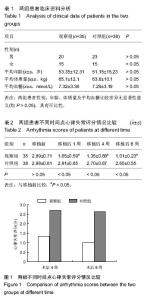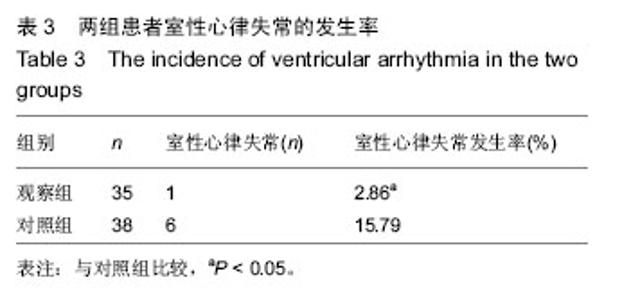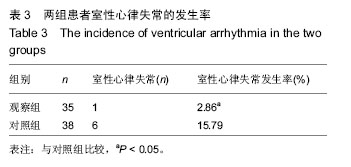| [1] 韦方,罗罕,李安杰,等.冠状动脉内脐血干细胞移植对冠心病患者室性心律失常的影响[J].江苏实用心电学杂志, 2012,21(1):19-20,22.
[2] 桑旭.新生儿脐血单核干细胞移植治疗冠心病合并心衰安全性初步观察[D].辽宁中医药大学,2010.
[3] 罗罕,李安杰,周永刚,等.超选择性冠状动脉内脐血干细胞移植治疗冠心病的初步研究[J].贵州医药,2013,37(3): 206-208.
[4] Steinwender C,Hofmann R,Kypta A,et al.In-stent Restenosis in Bare Metal Stents Versus Sirolimus-eluting Stents After Primary Coronary Intervention for Acute Myocardial Infarction and Subsequent Transcoronary Transplantation of Autologous Stem Cells. Clin Cardiol. 2008;31(8):356-359.
[5] 张明,于乐.脐血单个核细胞移植治疗老年急性广泛前壁心肌梗死后心源性休克合并重度心力衰竭1例[J].中国组织工程研究,2012,16(1):99-102.
[6] Llano R,Epstein S,Zhou R et al.Intracoronary delivery of mesenchymal stem cells at high flow rates after myocardial infarction improves distal coronary blood flow and decreases mortality in pigs.Catheter Cardiovasc Interv.2009;73(2):251-257.
[7] 罗涛,李玉明.心脏干细胞移植电生理效应及其致心律失常机制[J].武警医学院学报,2007,16(5):576-579.
[8] Chugh AR,Beache GM,Loughran JH,et al.Administration of Cardiac Stem Cells in Patients With Iscfaemk Cardiomyopathy: The SCIPIO Trial Surgical Aspects and Interim Analysis of Myocardial Function and Viability by Magnetic Resonance. Circulation. 2012;126(11 Suppl 1):S54- S64.
[9] Karantalis V,DiFede DL,Gerstenblith G,et al.Autologous mesenchymal stem cells produce concordant improvements in regional function, tissue perfusion, and fibrotic burden when administered to patients undergoing coronary artery bypass grafting: The prospective randomized study of mesenchymal stem cell therapy in patients undergoing cardiac surgery (PROMETHEUS) trial.Circ Res.2014; 114(8): 1302-1310.
[10] 丁旵东.骨髓间充质干细胞心肌移植后室性心律失常的危险性评估及其机制分析[D].南京医科大学,2006.
[11] 李华,王联发,周文兵,等.缺血性心肌病的细胞治疗进展[J].临床心血管病杂志,2011,27(7):483-485.
[12] Mathiasen AB,Haack-Sørensen M,Jørgensen E,et al.Autotransplantation of mesenchymal stromal cells from bone-marrow to heart in patients with severe stable coronary artery disease and refractory angina - Final 3-year follow-up.Int J Cardiol.2013;170(2):246-251.
[13] 齐晓勇,孟存良,党懿,等.自体骨髓间充质干细胞移植对急性心肌梗死后心律失常影响的实验研究[J].中华心血管病杂志,2008,36(6):546-550.
[14] Ripa RS, Wang Y, Jorgensen E, et al.Safety of Bone Marrow Stem Cell Mobilization Induced by Granulocyte-Colony Stimulating Factor: 30 Days' Blinded Clinical Results from the Stem Cells in Myocardial Infarction (STEMMI) Trial.Heartdrug: excellence in cardiovascular trials.2005;5(4):177-182.
[15] 王彤,郑韶欣,周长青,等.心肌干细胞移植可改进心力衰竭大鼠室颤阈值和电生理的稳定性[J].中国组织工程研究与临床康复,2011,15(36):6753-6756.
[16] 刘勇.心力衰竭的干细胞疗法与致心律失常作用[J].生物医学工程与临床,2010,14(5):470-471.
[17] Ahn CM,Hong SJ,Choi SC,et al.Red ginseng extract improves coronary flow reserve and increases absolute numbers of various circulating angiogenic cells in patients with first ST-segment elevation acute myocardial infarction.Phytother Res.2011;25(2):239-249.
[18] 苏枫,王加红,陈楠楠,等.AKT/PI3K信号通路介导的干细胞动员在抗心梗后心律失常中的作用[J].中国心血管病研究,2014,12(8):732-735.
[19] Kim BO,Tian H,Prasongsukarn K,et al.Cell transplantation imp roves ventricular function after a myocardial infarction:a preclinical study of human unrestricted somatic stem cells in a porcine model. circulation.2005;112:96-104.
[20] Irata Y,Sata M,Motomura N,et al.Human umbilical cord blood cells improve cardiac function after myocardial infarction.Biochem Bjo phys Res Commun. 2005;327: 609-614.
[21] Tse W,Laughlim MJ.UmbilicaI cord blood transplantation. a new alternative option.Hematology Am Soc Hematol Educ Program.2005: 377-383.
[22] Tomanek RJ,Christensen LP,Simons M, et al. Embryonic coronary vasculogenesis and angiogenesis are regulated by interactions between multiple FGFs and VEGF and are influenced by mesenchymal stem cells. Dev Dyn.2010;239(12):3182-3191.
[23] 余红,朱锦云,王建安,等.干细胞治疗缺血性心肌病研究进展[J].中国介入心脏病学杂志,2015,23(5):286-290.
[24] 徐红新,田毅浩,蒋学俊,等.骨髓干细胞移植对大鼠急性心肌梗死后室性心律失常的影响[J].中国心脏起搏与心电生理杂志,2007,21(4):358-360.
[25] 王世宏.干细胞在治疗冠心病中的应用[J].中华老年心脑血管病杂志,2008,10(11):873-874.
[26] 崔斌,黄岚,宋耀明,等.冠心病患者循环内皮祖细胞与相关危险因素及冠状动脉病变的关系[J].中华心血管病杂志, 2005,33(9):785-788.
[27] 王宁双.干细胞在心血管疾病治疗中的应用[J].中国组织工程研究与临床康复,2007,11(37):7461-7464.
[28] 闫新慧,高永举,谢建,等.用核素心脏显像评价冠心病患者骨髓干细胞移植术的效果[J].中华核医学杂志,2004, 24(5):279-281.
[29] 周芳,张馥敏,杨志健,等.自体骨髓间充质干细胞和单个核细胞移植治疗冠心病的临床研究[J].中国介入心脏病学杂志,2004,12(5):270-273.
[30] Price MJ, Chou CC, Frantzen M, et al. Intravenous mesen-chymal stern cell therapy early after repeffused acute myocardial infarction improves left ventrieular function and alters electrophysiologic properties.Int J Cardiol.2006;1l l(2):231-239.
[31] 种朝阳,臧伟进,周筠,等.iPSCs在心律失常疾病体外模型方面的研究进展[C].全国第十三届心脏学会、第十六届心功能学会和《心脏杂志》编委会联合学术会议,2013: 711-715.
[32] Donmez A,Zoghi M,Cagirgan S et al.The effect of hematopoietic progenitor cells' temperature on cardiac arrhythmias in patients given peripheral blood progenitor cells. Transfus Apher Sci.2006;34(3): 245-251.
[33] 曹青,洪葵.干细胞治疗心血管疾病现状及展望[J].中国心脏起搏与心电生理杂志,2010,24(1):80-82. |



